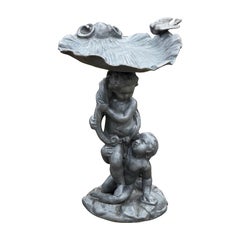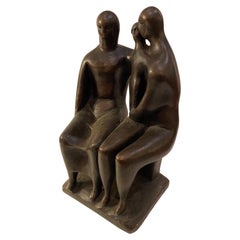Henry Moore Statue
English 1860s Lead Cherub & Aluminum Seashell Birdbath Statue
By John Cheere, Henry Moore, Van Nost Workshop
Located in Bensalem, PA
Stunning restored lead and aluminum original English 1850s birdbath please look at pictures and video for overall details & measurements feel free to reach out with any additional qu...
Category
Antique 1850s English Art Nouveau Statues
Materials
Aluminum, Lead
Henry Moore, "Pandora and The Imprisoned Statues, " hand signed
By Henry Moore
Located in Chatsworth, CA
This piece is a rare trial proof created by Henry Moore in 1950. It is from a portfolio entitled
Category
1950s Modern More Prints
Materials
Lithograph
$4,950
H 12.75 in W 8.75 in
Henry Moore Austin Productions
By Henry Moore, Austin Productions
Located in Philadelphia, PA
Austin productions Henry Moore Style Statue. Signed and dated 1964 to back. In overall very good
Category
Vintage 1960s American Mid-Century Modern Abstract Sculptures
Materials
Plaster
Recent Sales
Pandora and The Imprisoned Statues
By Henry Moore
Located in Chatsworth, CA
This piece is an original lithograph created by Henry Moore in 1950. It is from a portfolio
Category
1950s Modern More Prints
Materials
Lithograph
People Also Browsed
"La Ligne" Limited Edition Art Print by Christiane Lemieux - 40" x 40"
Located in New York, NY
"La Ligne" is a limited edition fine art print that captivates the viewer with its gorgeous abstract linework, demonstrating the beauty of simplicity and the power of form. The prin...
Category
2010s American Modern Contemporary Art
Materials
Paper
$2,624 / item
H 40 in W 40 in D 0.03 in
Manly P Hall, the Secret Teachings of All Ages, First Edition Book & 4 Prints
By TASCHEN
Located in Los Angeles, CA
The classic encyclopedia of the arcane in an expanded edition.
Renowned philosopher and lecturer Manly P. Hall’s masterful encyclopedia of ancient symbols, hidden rituals, and arcan...
Category
21st Century and Contemporary Books
Materials
Foil
$500 / item
H 18.7 in W 13.2 in D 3 in
Newton Red Brown Side Table
Located in Paris, FR
Side Table Newton Red Brown with all
structure in stoneware in glazed finish.
Category
21st Century and Contemporary Belgian Side Tables
Materials
Sandstone
Mobius H6 25/50 - large, smooth, black granite, abstract, outdoor sculpture
By Jeremy Guy
Located in Bloomfield, ON
This sculpture is numbered in an edition of 50 and can be purchased on a commission basis, please allow 8 - 12 weeks before shipping. The sculpture weighs about 600 lbs and different...
Category
2010s Contemporary Abstract Sculptures
Materials
Granite, Stainless Steel
$30,000
H 77 in W 21 in D 17 in
Murmuration - Large scale, smooth and polished, black granite outdoor sculpture
By Jeremy Guy
Located in Bloomfield, ON
Engineered black granite is sculpted by Jeremy Guy into an elegant swirling abstraction inspired by the flocking behaviour of starlings. Called a murmuration, this phenomenal aerial ...
Category
2010s Abstract Abstract Sculptures
Materials
Granite
$64,000
H 99 in W 60 in D 36 in
"Looking Away" by Mark Bradley Schwartz, Oil Painting, Female Nude Portrait
By Mark Bradley Schwartz
Located in Denver, CO
Mark Bradley Schwartz’s "Looking Away" (2020) is a masterful example of contemporary figurative realism, executed in oil on board. This original, handmade painting captures a quiet, ...
Category
2010s Realist Nude Paintings
Materials
Oil, Board
French 19th Century Restauration Center Table
Located in Baton Rouge, LA
A handsome French Restauration center table made of burl mahogany. The original Saint Anne marble top rests above a three-sided concave mahogany base with gilt bronze ormolu. The ori...
Category
Antique 19th Century French Restauration Gueridon
Materials
Marble, Brass
Mother-of-Pearl Mexican Silver Box
By Taxco
Located in Philadelphia, PA
Mexican silver box with Mother-of-Pearl Inlay. Lid opens to a wood lined interior. Very nicely done and a really beautiful object!
Category
Vintage 1950s Mexican Mid-Century Modern Sterling Silver
Materials
Silver
Pablo Picasso Estate Hand Signed Cubist Lithograph Abstract Flowers Bouquet
By Pablo Picasso
Located in Surfside, FL
Pablo Picasso (after)
"Le Bouquet" Bouquet of flowers, abstract floral arrangement.
limited edition print on Arches paper,
Hand signed by Marina Picasso lower right and numbered 244...
Category
20th Century Modern Abstract Prints
Materials
Lithograph
$4,000
H 29.5 in W 22 in
American Abstract Expressionist Mid Century Framed Vintage Oil Painting
Located in Buffalo, NY
Pure mid century abstract expressionist painting. Great colors and movement. Oil on canvas. Framed. No signature found.
Category
1960s Abstract Expressionist Abstract Paintings
Materials
Canvas, Oil
$3,580 Sale Price
20% Off
H 36 in W 24 in D 2 in
George Nelson for Herman Miller Pedestal/ Side Table
By Herman Miller, George Nelson
Located in Philadelphia, PA
George Nelson for Herman Miller Pedestal Table. Aluminum Base with a formica top and maple edge. Classic, useful design! Very clean example!
Category
2010s American Mid-Century Modern Side Tables
Materials
Metal
Antique French Craftsman Work coffee table circa 19th century
Located in Labrit, Landes
French work coffee table made in the 19th century
This carpenter work bench is perfect to be used as a coffee table, an end bed or a entry hall bench full of character
The scratches...
Category
Antique 19th Century French French Provincial Console Tables
Materials
Abalone
$1,239 Sale Price
41% Off
H 29.73 in W 38.59 in D 17.33 in
George Nakashima attributed Panel
By George Nakashima Studio
Located in Philadelphia, PA
George Nakashima attributed Shoji Screen. This was custom built for the backside of a Danish Credenza that was put into the middle of a room that was occupied with all Nakashima pie...
Category
Vintage 1970s American Mid-Century Modern Screens and Room Dividers
Materials
Natural Fiber, Wood
SIX HEADS - OLYMPIANS
By Henry Moore
Located in Portland, ME
Moore, Henry (British, 1898-1986). SIX HEADS - OLYMPIANS. (C. 657), 1983. Lithograph in colors on Arches paper, signed in pencil and numbered XXV/XXXV (Artist's Proofs additional to ...
Category
1980s Figurative Prints
Materials
Lithograph
Pair of Apel Ottomans by Bernhardt Design, 2011
By Bernhardt Design
Located in Philadelphia, PA
Pair of Apel Ottomans
Jessica Pell for Bernhardt Design
2011
"in very good vintage conditions"
"espresso / warm grey color fabric"
"Eye candy for your home. The Apel Ottoman by Be...
Category
21st Century and Contemporary American Modern Ottomans and Poufs
Materials
Fabric, Upholstery
20th Century German Modernist Oil Painting Artists Paint Colours
Located in Cirencester, Gloucestershire
Artist: Elisabeth Hahn (German 1924-2021),
Elisabeth Hahn was born in Dortmund, Germany, where she began her artistic studies. In 1953, she moved to Paris. She continued her studie...
Category
20th Century Modern Abstract Paintings
Materials
Oil
$756 Sale Price
30% Off
H 8.5 in W 11.5 in
Get Updated with New Arrivals
Save "Henry Moore Statue", and we’ll notify you when there are new listings in this category.
Henry Moore Statue For Sale on 1stDibs
You are likely to find exactly the henry moore statue you’re looking for on 1stDibs, as there is a broad range for sale. You can easily find an example made in the modern style, while we also have 3 modern versions to choose from as well. You’re likely to find the perfect henry moore statue among the distinctive items we have available, which includes versions made as long ago as the 20th Century as well as those made as recently as the 21st Century. When looking for the right henry moore statue for your space, you can search on 1stDibs by color — popular works were created in bold and neutral palettes with elements of gold, beige, gray and brown. There have been many interesting henry moore statue examples over the years, but those made by Sara Ingleby-Mackenzie, Henry Moore and Marino Marini are often thought to be among the most thought-provoking. Artworks like these of any era or style can make for thoughtful decor in any space, but a selection from our variety of those made in bronze, metal and etching can add an especially memorable touch.
How Much is a Henry Moore Statue?
A henry moore statue can differ in price owing to various characteristics — the average selling price for items in our inventory is $3,363, while the lowest priced sells for $495 and the highest can go for as much as $17,437.
More Ways To Browse
Vintage Austin Productions
Vintage Austin Sculptures
Austin Office Furniture Used
Austin Plaster Sculpture
Henry Moore Style
Austin Black Plaster Sculpture
Austin Production 1960
Henry Moore Plaster
Sandra Gamarra
Schnabel Poster
Seattle Worlds Fair Poster
Shelby And Sandy
Shepard Fairey Love Lotus
Shinduk Kang
Snoopy Tennis
Sorrento Vintage Poster
South East Asia Poster
Spa Francorchamps Vintage Poster

